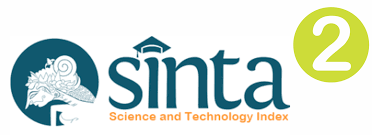Media discourse and coalition dynamics: Playing safe is the new trend in media coalition
Abstract
This study investigates the cautious approach adopted by media coalitions in framing the discourse surrounding the alteration of the age limit policy for vice presidential candidates in Indonesia in 2024. Using the Discourse Coalition Framework (DCF) and Discourse Network Analysis (DNA), the research explores how media outlets form coalitions through nuanced discourse strategies. This study aims to analyze how online media in Indonesia builds narratives related to changes in the policy of the age limit for vice presidential candidates in the 2024 election. The analysis finds that MediaIndonesia.com and Tempo.co take a non-oppositional stance, crafting narratives that are intentionally cautious and open to multiple interpretations to avoid direct challenges to the MK's decision. This careful positioning often involves complex language that can obscure understanding for the general public, limiting non-experts’ grasp of the legal context. Viva.co.id, however, diverges by presenting clearer narrative patterns that align with specific political coalitions, focusing on justifications and perceived benefits. The study highlights that dominant discourses are often driven by influential figures such as academics, legal experts, and politicians, who serve as primary sources and reinforce the coalition’s influence over public opinion. The application of DNA provides insights into how these actors and their discourses shape public understanding and frame the urgency and legitimacy of the policy. This study underscores that in modern media coalitions, a strategy of "playing safe" is becoming a prevalent approach to managing public perception and discourse on politically sensitive issues.
Keywords
Full Text:
PDFReferences
Angermuller, J. (2014). Poststructuralist Discourse Analysis. Poststructuralist Discourse Analysis. https://doi.org/10.1057/9781137442475
Atkinson, J. D., & Cooley, L. (2019). Narrative capacity, resistance performance, and the “shape” of new social movement networks. Communication Studies, 61(3), 321–338. https://doi.org/10.1080/10510971003752668
Brandes, U., & Wagner, D. (2004). Analysis and Visualization of Social Networks BT - Graph Drawing Software (M. Jünger & P. Mutzel (eds.); pp. 321–340). Springer Berlin Heidelberg. https://doi.org/10.1007/978-3-642-18638-7_15
Eriyanto. (2022). Analisis jejaring wacana discourse network analysis. PT. Remaja Rosdakarya.
Eriyanto, & Ali, D. J. (2020). Discourse network of a public issue debate: A study on covid-19 cases in indonesia. Jurnal Komunikasi: Malaysian Journal of Communication, 36(3), 209–227. https://doi.org/10.17576/JKMJC-2020-3603-13
Fergie, G., Leifeld, P., Hawkins, B., & Hilton, S. (2019). Mapping discourse coalitions in the minimum unit pricing for alcohol debate: a discourse network analysis of UK newspaper coverage. Addiction, 114(4), 741–753. https://doi.org/10.1111/add.14514
Ghinoi, S., & Steiner, B. (2020). The political debate on climate change in Italy: A discourse network analysis. Politics and Governance, 8(2), 215–228. https://doi.org/10.17645/pag.v8i2.2577
Hajer, M. (2006). Doing Discourse Analysis : Coalitions , Practices , Meaning. January 2006.
Hajer, M. A. (1993). Discourse Coalitions and the Institutionalization of Practice. In The Argumentative Turn in Policy Analysis and Planning (Issue August). https://doi.org/10.1215/9780822381815-003
Ibrahim, I. S., Amirudin, A., & Kustiman, E. (2023). Representations of Stunting in Indonesian National Newspaper: Positioning a Culture-Oriented Approach. Mediator: Jurnal Komunikasi, 16(2), 290–302. https://doi.org/10.29313/mediator.v16i2.2922
Jin, Y., Schaub, S., Tosun, J., & Wesseler, J. (2022). Does China have a public debate on genetically modified organisms? A discourse network analysis of public debate on Weibo. Public Understanding of Science, 31(6), 732–750. https://doi.org/10.1177/09636625211070150
Krebs, R. R. (2015). Narrative and the Making of US National Security. Narrative and the Making of US National Security. https://doi.org/10.1017/CBO9781316218969
Leifeld, P. (2016). Discourse Network Analysis: Policy Debates as Dynamic Networks. In J. N. Victor, A. H. Montgomery, & M. Lubell (Eds.), The Oxford Handbook of Political Networks (p. 0). Oxford University Press. https://doi.org/10.1093/oxfordhb/9780190228217.013.25
Leifeld, P. (2017). Discourse Network Analysis: Policy Debates as Dynamic Networks. The Oxford Handbook of Political Networks, July 2016, 301–326.
Leifeld, P., & Haunss, S. (2012). A Comparison between Political Claims Analysis and Discourse Network Analysis: The Case of Software Patents in the European Union. SSRN Electronic Journal. https://doi.org/10.2139/ssrn.1617194
Mamonto, M. A. W. W. (2019). LEGAL POLITICS OF SIMPLIFYING POLITICAL PARTIES IN INDONESIA (Case Study of 2004-2014 Election). Substantive Justice International Journal of Law, 2(1), 1. https://doi.org/10.33096/substantivejustice.v2i1.25
Müller, S. (2020). Media Coverage of Campaign Promises Throughout the Electoral Cycle. Political Communication, 37(5), 696–718. https://doi.org/10.1080/10584609.2020.1744779
Pujianti, S., & Agustina, T. (2024). PSI Minta Batas Usia Minimal Capres-Cawapres 35 Tahun - Mahkamah Konstitusi Republik Indonesia. Mahkamah Konstitusi Republik Indonesia. https://www.mkri.id/index.php?page=web.Berita&id=19076&menu=2https://www.mkri.id/public/content/persidangan/putusan/putusan_mkri_9329_1697427307.pdf
Scott, J., & Carrington, P. J. (2011). The SAGE Handbook of Social Network Analysis.
Wang, C., & Wang, L. (2017). Unfolding policies for innovation intermediaries in China: A discourse network analysis. Science and Public Policy, 44(3), 354–368. https://doi.org/10.1093/scipol/scw068
DOI: http://dx.doi.org/10.30813/bricolage.v11i1.6561
Refbacks
- There are currently no refbacks.
Accredited by:
Indexed by:
UNIVERSITAS BUNDA MULIA PRESS
PROGRAM STUDI MAGISTER ILMU KOMUNIKASI
Lantai 3 Ruang Pascasarjana - Universitas Bunda Mulia
Jl. Lodan Raya No. 2, Ancol – Jakarta Utara 14430, Indonesia
Telp: +62 21 692 9090 ext.1317
Email: bricolage@ubm.ac.id; bricolage.mikom@gmail.com
This work is licensed under a Creative Commons Attribution-ShareAlike 4.0 International License.
View My Stats




























.png)

